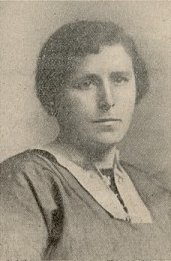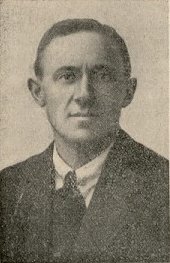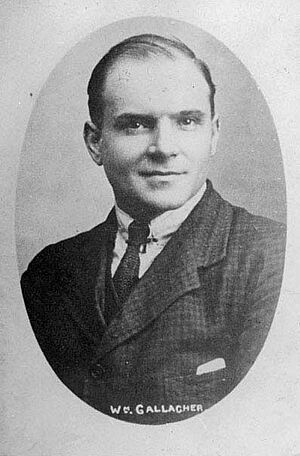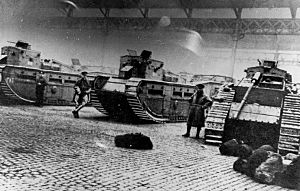Red Clydeside facts for kids
"Red Clydeside" was an important time of political change in Glasgow, Scotland, from the 1910s to the early 1930s. The name also referred to the area along the River Clyde, including towns like Clydebank, Greenock, Dumbarton, and Paisley. The story of Red Clydeside is a big part of the history of the labour movement, which is about working people joining together to improve their lives.
At the time, some newspapers used the name "Red Clydeside" to talk down to the people who were demanding big changes. This period of change happened because of strong leaders, organized groups, and a general feeling that things needed to be different. It all started with working-class people disagreeing with Britain's role in the First World War. The area already had a history of people asking for change, going back to events like the "Radical War" of 1820.
Contents
Early Worker Protests
In 1911, a big strike happened at the Singer sewing machine factory in Clydebank. About 11,000 workers walked out to support 12 of their female co-workers. The women were protesting a new work system that made them do more work for less pay.
After the strike, the company fired 400 workers. This included the leaders of the strike and people believed to be part of workers' groups. One of them was Arthur McManus, who later became the first chairman of the Communist Party of Great Britain.
Between 1910 and 1914, workers in Clydeside, especially women and those in unskilled jobs, became much more active in demanding better conditions. The number of people in Scottish trade unions almost doubled in these years.
Speaking Out Against World War I
To organize workers against the First World War, the Clyde Workers' Committee (CWC) was formed. Its leader was Willie Gallacher. The CWC led protests against a new law called the Munitions of War Act 1915. This law stopped engineers from leaving their jobs to work somewhere else.
The CWC leaders met with the government, but they could not agree. Because of their protest activities, Gallacher and another leader, David Kirkwood, were arrested under a special wartime law.
People also protested against the war on the streets. John Maclean and James Maxton of the Independent Labour Party (ILP) also faced serious consequences for their anti-war work.
The Women's Peace Crusade
Helen Crawfurd was a leader who was strongly against the war. She noticed that most anti-war groups were run by middle-class women, and working-class women didn't have much of a voice.
So, in 1916, Helen and her friend Agnes Dollan started the Women's Peace Crusade (WPC). They held outdoor meetings all over Glasgow and other parts of Scotland. They wanted to get more working-class women involved in activism.
The WPC became very successful. In July 1917, they organized a huge demonstration at Glasgow Green, a famous park in the city. About 14,000 people marched with banners and music. The WPC grew and eventually had groups all across the United Kingdom.
The Famous Rent Strikes of 1915

At the start of the 20th century, Glasgow's population grew very quickly. Many people moved to the city for work. But there were not enough houses for everyone.
Landlords saw they could make more money by raising the rent on the homes that were available. This made it very hard for families to afford a place to live. Between 1912 and 1915, Glasgow's population grew by 65,000, but only 1,500 new homes were built.
In 1914, a group called the Glasgow Women's Housing Association was formed. It was led by brave women like Mary Barbour, Mary Laird, and Helen Crawfurd. In May 1915, they started a rent strike. This meant thousands of tenants, mostly women, refused to pay rent increases.
When landlords tried to evict families, the women would block the way and protest. The strikes spread across the city. By November 1915, about 20,000 tenants were on strike. The protests got so big that the government had to listen. In December, a new law, the Rents and Mortgage Interest Restriction Act 1915, was passed. It froze rents at their pre-war levels.
To honor her work, a bronze statue of Mary Barbour leading the strikers was put up in Govan in 2018.
The Fight for a Shorter Work Week
After the war ended, people continued to campaign for better working conditions. One of the biggest goals was to get a 40-hour work week.
On January 31, 1919, the trade unions organized a huge rally in George Square, in the center of Glasgow. Thousands of people gathered to show their support. The protest became chaotic, and clashes broke out between some protesters and the police.
The situation was so serious that the city's sheriff called for military help. Soldiers and even six tanks were sent to Glasgow to keep order. This event showed how tense things were in the city. It happened not long after the Russian Revolution, and governments were worried about similar events happening elsewhere.
Several of the strike leaders, including Manny Shinwell and William Gallacher, faced consequences for their part in the day's events.
"Reds" in Parliament
The ideas of Red Clydeside became very popular with working-class people. Instead of voting for the Liberal Party as they had before, many started to support the Labour Party.
This led to a big change in the 1922 general election. Many of the "Red Clydesiders" were elected to the House of Commons. This meant they could now represent working people in the government. Some of these new Members of Parliament (MPs) were Maxton, Wheatley, Shinwell, and Kirkwood.
In Parliament, these MPs were known for being on the left-wing of the Labour Party. They often criticized their own party's leaders when they felt the government was not doing enough for the workers.
The Legacy of Red Clydeside

The Red Clydeside era had a long-lasting impact on Glasgow. The city became famous for its political activism and strong trade unions. For many years, the Labour Party was the most popular party in Glasgow.
This period of history is still an important story for people on the political left in Scotland. The story of the "Red Clydesiders" continues to inspire people who want to fight for social change.




